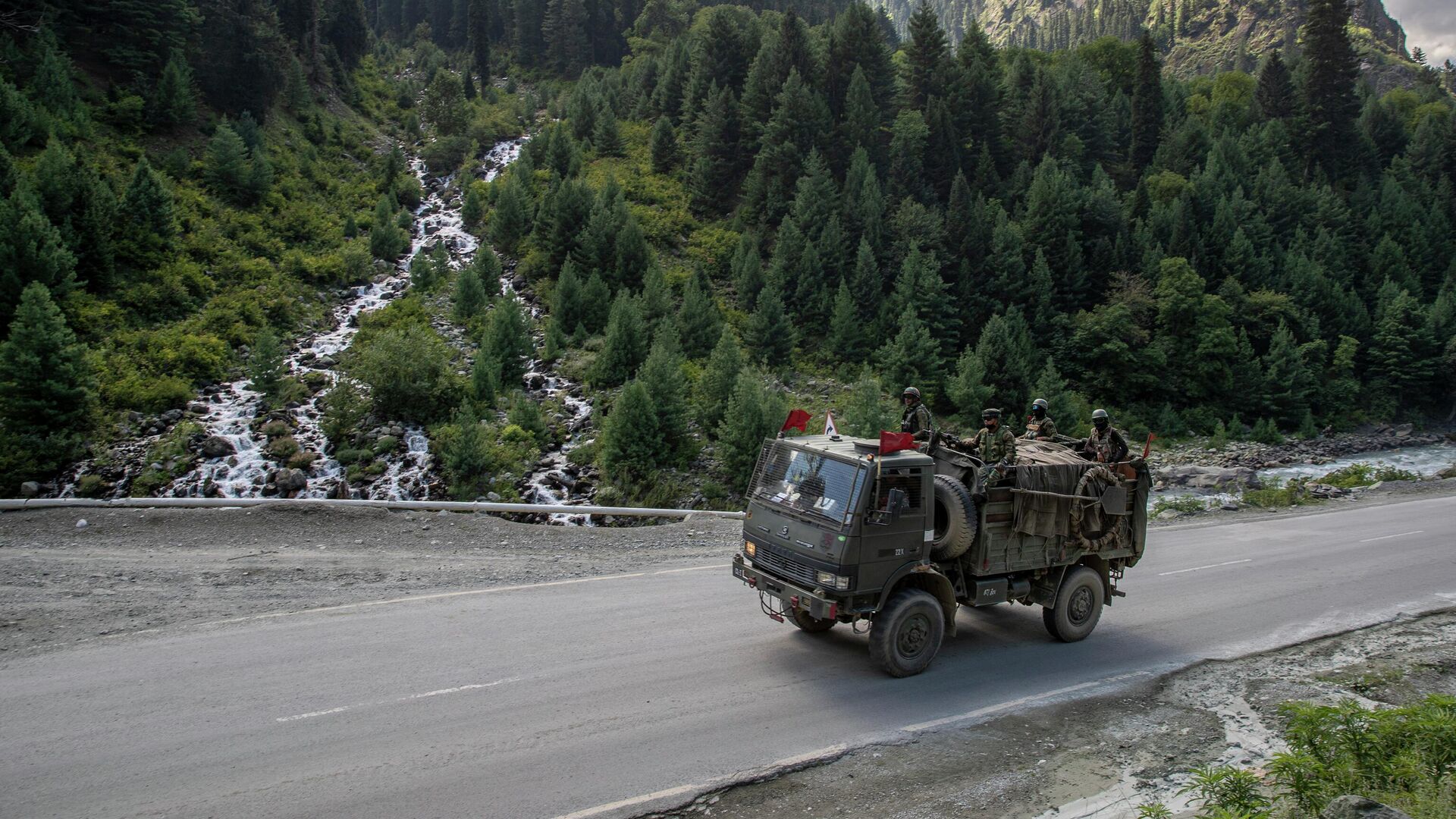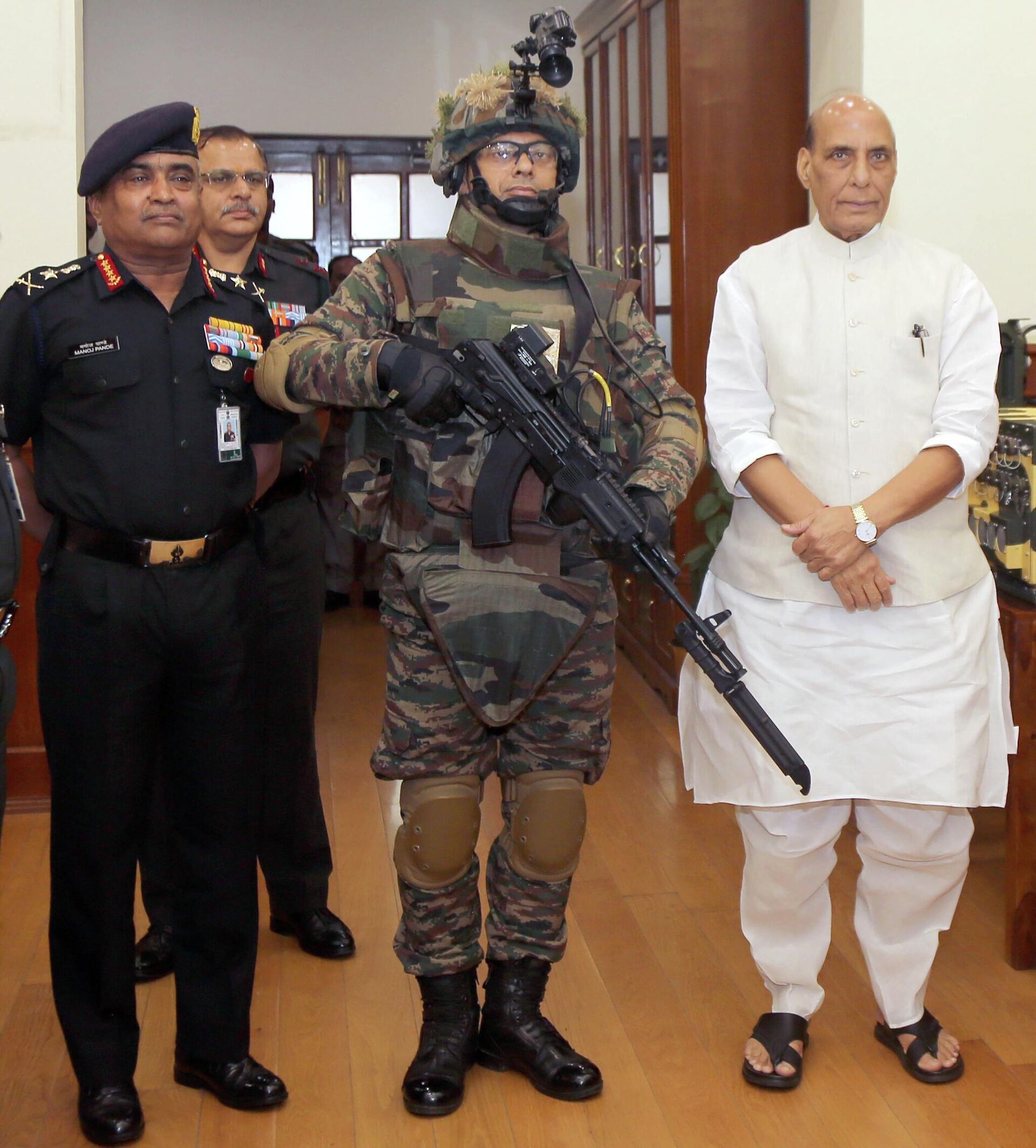https://sputnikglobe.com/20220816/india-presents-futuristic-soldier-deploys-modern-fighting-vehicles-along-border-with-china-1099655197.html
India Presents Futuristic Soldier, Deploys Modern Fighting Vehicles Along Border With China
India Presents Futuristic Soldier, Deploys Modern Fighting Vehicles Along Border With China
Sputnik International
India’s Ministry of Defense has inducted a range of modern weapons since 2018 to infuse lethality and improve the surveillance capabilities of its infantry to... 16.08.2022, Sputnik International
2022-08-16T14:07+0000
2022-08-16T14:07+0000
2022-08-16T14:08+0000
india
china
rajnath singh
indian army
pla
people's liberation army (pla) navy
ladakh standoff
ak-203
t-90
tanks
https://cdn1.img.sputnikglobe.com/img/07e6/08/10/1099656256_0:320:3072:2048_1920x0_80_0_0_7598d7ae1666e8e75beca409f0c39623.jpg
India offered a first glance at its modern infantry along the border with China on Tuesday, with Defense Minister Rajnath Singh handing over a range of cutting-edge wear and gear to the Indian troops in the eastern Ladakh region.The entire wear and gear, including the AK-203, weigh around 14 kg.Singh also welcomed the first-ever deployment of assault landing craft in the contested Pangong lake - a landlocked water body divided between India and China. The LCA can carry 35 troops and thus has enhanced the capability to operate across water obstacles in eastern Ladakh.The Indian Army also inducted mini UAVs and multirole mobility vehicles, empowering the infantry battalion, which has been facing thousands of PLA troops since June 2020 in the rugged terrain of the Himalayas.Troops deployed at frontier bases received a significant boost in surveillance and detection with the induction of handheld thermal imagers. The uncooled imager gives round-the-clock visibility of vehicles up to 3 km and human targets at 1.5 km, even in the adverse weather conditions of the Himalayas.The government has also supplied third-generation thermal imaging sights for the T-90 tanks deployed in eastern Ladakh, which can function at a temperature of minus 20 degrees Celsius.As part of its plan for a major overhaul of its infantry weapons, the Indian Defense Ministry has acquired a range of weapons, including assault rifles, light machine guns, submachine guns, and man-portable anti-tank-guided missiles since 2018 under fast-track procurement processes.Due to the ongoing border standoff with China, the Indian Army has been carrying out rebalancing to deploy additional troops along the 3,488 km border with the neighboring country.Prior to the Ladakh standoff, when 20 Indian soldiers and four Chinese troops were killed in a hand-to-hand fight in June 2020, only 4.5 Army corps out of the total 14 faced the China border. Similarly, just 12 of the Army’s 38 divisions deployed to look after the northern border; less than half of the divisions were dedicated to the India-Pakistan border.
china
ladakh standoff
Sputnik International
feedback@sputniknews.com
+74956456601
MIA „Rossiya Segodnya“
2022
Rishikesh Kumar
https://cdn1.img.sputnikglobe.com/img/07e4/08/04/1080055820_0:0:388:389_100x100_80_0_0_40018ee210946d65d49ffba4f4c008e1.jpg
Rishikesh Kumar
https://cdn1.img.sputnikglobe.com/img/07e4/08/04/1080055820_0:0:388:389_100x100_80_0_0_40018ee210946d65d49ffba4f4c008e1.jpg
News
en_EN
Sputnik International
feedback@sputniknews.com
+74956456601
MIA „Rossiya Segodnya“
Sputnik International
feedback@sputniknews.com
+74956456601
MIA „Rossiya Segodnya“
Rishikesh Kumar
https://cdn1.img.sputnikglobe.com/img/07e4/08/04/1080055820_0:0:388:389_100x100_80_0_0_40018ee210946d65d49ffba4f4c008e1.jpg
india, china, rajnath singh, indian army, pla, people's liberation army (pla) navy, ladakh standoff, ak-203, t-90, tanks
india, china, rajnath singh, indian army, pla, people's liberation army (pla) navy, ladakh standoff, ak-203, t-90, tanks
India Presents Futuristic Soldier, Deploys Modern Fighting Vehicles Along Border With China
14:07 GMT 16.08.2022 (Updated: 14:08 GMT 16.08.2022) India’s Ministry of Defense has inducted a range of modern weapons since 2018 to infuse lethality and improve the surveillance capabilities of its infantry to cater to future battlefields. Since the Galwan clash in 2020, the Indian Army has also been rebalancing its forces on the Indo-Chinese border.
India offered a first glance at its modern infantry along the border with China on Tuesday, with Defense Minister Rajnath Singh handing over a range of cutting-edge wear and gear to the Indian troops in the eastern Ladakh region.
The Future Infantry Soldier, or F-INSAS, equipped with an AK-203 along with day and night holographic and reflex sights, has a specially designed helmet, bulletproof jacket, and communication and surveillance system that provides better survivability, improved surveillance, and communications capabilities, resulting in a lean and mean force.
The entire wear and gear, including the AK-203, weigh around 14 kg.
Singh also welcomed the first-ever deployment of assault landing craft in the contested Pangong lake - a landlocked water body divided between India and China. The LCA can carry 35 troops and thus has enhanced the capability to operate across water obstacles in eastern Ladakh.
The Indian Army also inducted mini UAVs and multirole mobility vehicles, empowering the infantry battalion, which has been facing thousands of PLA troops since June 2020 in the rugged terrain of the Himalayas.
Troops deployed at frontier bases received a significant boost in surveillance and detection with the induction of handheld thermal imagers. The uncooled imager gives round-the-clock visibility of vehicles up to 3 km and human targets at 1.5 km, even in the adverse weather conditions of the Himalayas.
The government has also supplied third-generation thermal imaging sights for the T-90 tanks deployed in eastern Ladakh, which can function at a temperature of minus 20 degrees Celsius.
The vintage non-metallic Mine 14 was replaced with a new Indian one named "Nipun" to give better protection to troops on border, the Defense Ministry said.
As part of its plan for a major overhaul of its infantry weapons, the Indian Defense Ministry has
acquired a range of weapons, including assault rifles, light machine guns, submachine guns, and man-portable anti-tank-guided missiles since 2018 under fast-track procurement processes.
Due to the ongoing border standoff with China, the Indian Army has been carrying out rebalancing to deploy additional troops along the 3,488 km border with the neighboring country.
Prior to the Ladakh standoff, when 20 Indian soldiers and four Chinese troops were killed in a
hand-to-hand fight in June 2020, only 4.5 Army corps out of the total 14 faced the China border. Similarly, just 12 of the Army’s 38 divisions deployed to look after the northern border; less than half of the divisions were dedicated to the India-Pakistan border.



